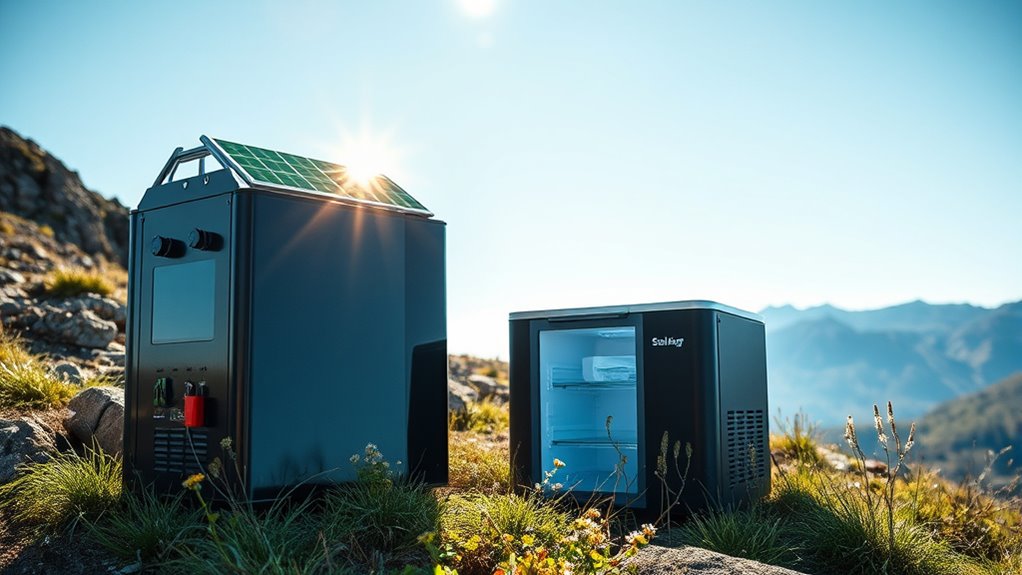Looking for reliable solar-powered battery banks to keep your fridge running off-grid? I recommend considering portable options like the Takki 120W Peak Solar Generator, the Portable Power Station 300W, or the Anker SOLIX C1000 with its high capacity and fast recharging. For extended use, units with 1024Wh LiFePO4 batteries or rugged designs are great. Keep in mind capacity, compatibility, and multiple charging options. If you continue, you’ll discover some of the best models suited for your needs.
Key Takeaways
- Assess battery capacity and wattage to ensure it can power your refrigerator continuously off-grid.
- Choose high-capacity lithium iron phosphate (LiFePO4) power stations for prolonged, reliable refrigeration.
- Consider solar panel efficiency and recharge times to maintain consistent power supply in remote locations.
- Ensure compatibility of output ports with your refrigerator’s power plug and voltage requirements.
- Evaluate durability and weatherproof features for outdoor or rugged use in off-grid environments.
Takki 120W Peak Solar Generator Portable Power Station with 21W Panels

If you’re looking for a portable solar-powered battery bank that’s perfect for outdoor adventures or emergency situations, the Takki 120W Peak Solar Generator is a top choice. It offers 88.8Wh capacity, enough to charge phones multiple times and power small devices like cameras, mini fridges, or fans. With 8 output ports—including AC outlets, USB, Type-C, and DC—it’s versatile and compatible with many gadgets. Weighing just over 2 pounds and measuring about 5.7 inches, it’s highly portable. Plus, the included foldable 21W solar panel makes recharging easy in sunlight, making it ideal for off-grid power needs.
Best For: outdoor enthusiasts, campers, and emergency preparedness individuals seeking a portable, versatile solar-powered power source for small devices and off-grid use.
Pros:
- Compact, lightweight design weighing just over 2 pounds for easy portability
- Multiple output options including AC, USB, Type-C, and DC for versatile device compatibility
- Equipped with a foldable 21W solar panel for convenient recharging in sunlight
Cons:
- Limited capacity of 88.8Wh may not power larger or high-wattage devices for extended periods
- Charging speed via solar panel can be slower in less ideal sunlight conditions
- Cannot operate devices exceeding 80W peak power, limiting use with some appliances
Portable Power Station 300W (600W Peak), 220Wh Solar Power Bank with AC Outlets
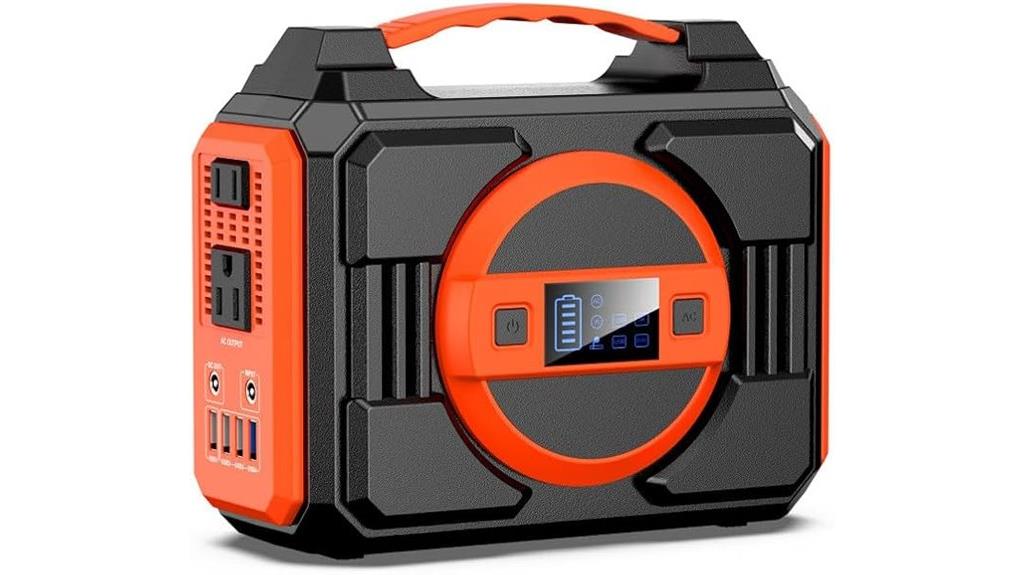
The Portable Power Station 300W (600W Peak) is an ideal choice for outdoor enthusiasts and emergency preparedness, thanks to its compact size and versatile charging options. Weighing just 5 pounds and measuring 8.5 x 6.7 x 4.1 inches, it’s easy to carry and store. With a 220Wh lithium-ion battery, it can power up to seven devices simultaneously, including small appliances under 300Wh. It offers multiple outlets—AC, USB, and DC—making it flexible for various needs. Recharged via wall, car, or solar panel (not included), it’s perfect for off-grid use, camping, or emergency backup, providing reliable portable power whenever you need it.
Best For: outdoor enthusiasts, campers, and emergency preparedness individuals seeking a portable, versatile power source to run small devices and appliances in off-grid or emergency situations.
Pros:
- Compact and lightweight design (5 lbs, 8.5 x 6.7 x 4.1 inches) for easy portability and storage
- Supports up to 7 devices simultaneously with multiple outlets including AC, USB, and DC ports
- Recharge options include wall outlet, car, and solar panel (not included), providing flexible power replenishment
Cons:
- Not suitable for high-capacity appliances like microwaves, refrigerators, or induction cookers
- Solar panel not included, requiring an additional purchase for solar recharging
- Limited battery capacity (220Wh) may not last long for extended power needs
MARBERO Solar Generator 155Wh with Portable Power Station and Solar Panel

For campers and outdoor enthusiasts seeking a reliable power source, the MARBERO Solar Generator 155Wh stands out thanks to its lightweight design and versatile charging options. Weighing just 5.35 pounds and compact enough to carry easily, it includes a 30W foldable solar panel that efficiently captures sunlight—even on cloudy days. With two AC outlets, USB-A ports, and DC outputs, I can charge laptops, mini-coolers, phones, and LED lamps simultaneously. Its LCD display shows real-time power data, and it recharges via wall, car, or solar in about 6-7 hours. Perfect for off-grid adventures, it combines portability with dependable renewable energy.
Best For: outdoor enthusiasts, campers, and emergency preparedness individuals seeking a portable, reliable power source for off-grid adventures and blackouts.
Pros:
- Lightweight and compact design weighing only 5.35 pounds for easy portability
- Versatile charging options including AC, USB-A, DC, and solar, supporting multiple devices simultaneously
- Efficient 30W foldable solar panel that captures sunlight on cloudy days, enabling sustainable recharging
Cons:
- Limited capacity of 155Wh may not power high-wattage devices for extended periods
- Recharge time of approximately 6-7 hours may be lengthy during urgent use
- Slightly higher price point compared to smaller or less feature-rich portable power stations
Anker SOLIX C1000 Gen 2 Portable Power Station
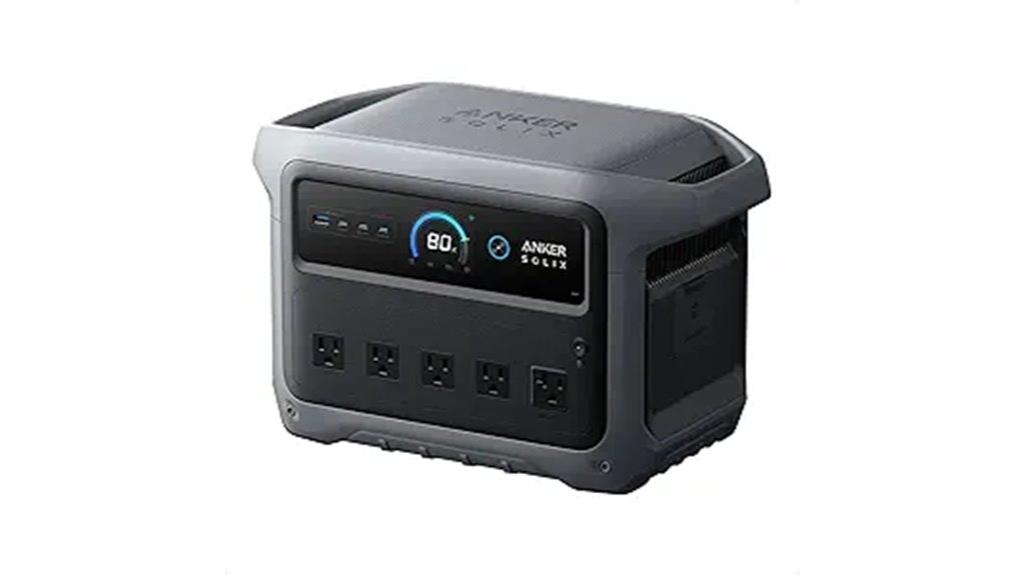
With its powerful 2,000W continuous output and 1,024Wh capacity, the Anker SOLIX C1000 Gen 2 Portable Power Station is an excellent choice for anyone needing reliable off-grid power to keep their refrigerator running. It supports up to 10 devices simultaneously through its versatile ports, making it perfect for emergency backup, camping, or home use. Recharging is quick—just 49 minutes with HyperFlash technology or 1.8 hours via solar input—ensuring you’re never without power. Its lightweight, durable design makes it easy to transport, while safety features like UPS backup and power management help protect your devices and optimize energy use.
Best For: individuals in need of reliable, portable backup power for emergency, camping, or home use with the ability to power multiple devices simultaneously.
Pros:
- High power capacity of 2,000W continuous and 1,024Wh, suitable for demanding devices.
- Rapid recharging in just 49 minutes using HyperFlash technology or 1.8 hours via solar input, ensuring minimal downtime.
- Compact and lightweight design, making it easy to carry and store, with durable construction for long-term use.
Cons:
- Limited to 10 device ports, which may be insufficient for very large setups.
- Solar input is capped at 600W, which may slow recharging in overcast conditions or for larger power needs.
- Higher initial cost compared to smaller or less feature-rich portable power stations.
Solar Powered Generator 200W Portable Solar Power Station with 40W Solar Panels
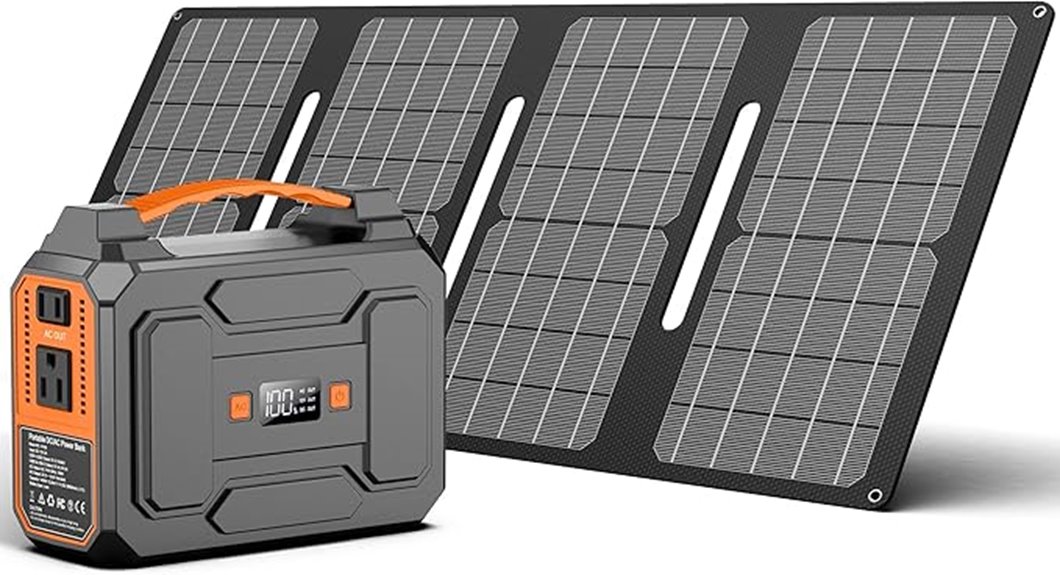
If you’re looking for a reliable portable power solution that can keep your devices running during outdoor adventures or emergencies, the 200W solar power station with 40W solar panels is an excellent choice. Its 40W monocrystalline panels boast a 20.5% efficiency, performing well even in low light. Weighing just 3.3 pounds, it’s lightweight and portable, perfect for camping or emergencies. With a 146Wh capacity, it charges laptops, phones, cameras, and small appliances simultaneously through multiple outlets. The built-in LED flashlight and safety features make it versatile and dependable, ensuring you stay powered when you need it most.
Best For: outdoor enthusiasts, campers, and emergency preparedness users seeking reliable portable power for devices and small appliances.
Pros:
- Lightweight and compact at only 3.3 pounds, making it highly portable for outdoor activities and travel
- High-efficiency 40W monocrystalline solar panels perform well even under low light conditions
- Multiple output options including AC, USB, and DC ports support charging various devices simultaneously
Cons:
- Limited capacity of 146Wh may not be sufficient for heavy or prolonged power needs
- Maximum output of 200W might restrict usage with higher-wattage appliances
- Solar panels are lightweight but may require extended sunlight exposure for full charge in cloudy conditions
Power Bank Solar Charger 42800mAh with Flashlight
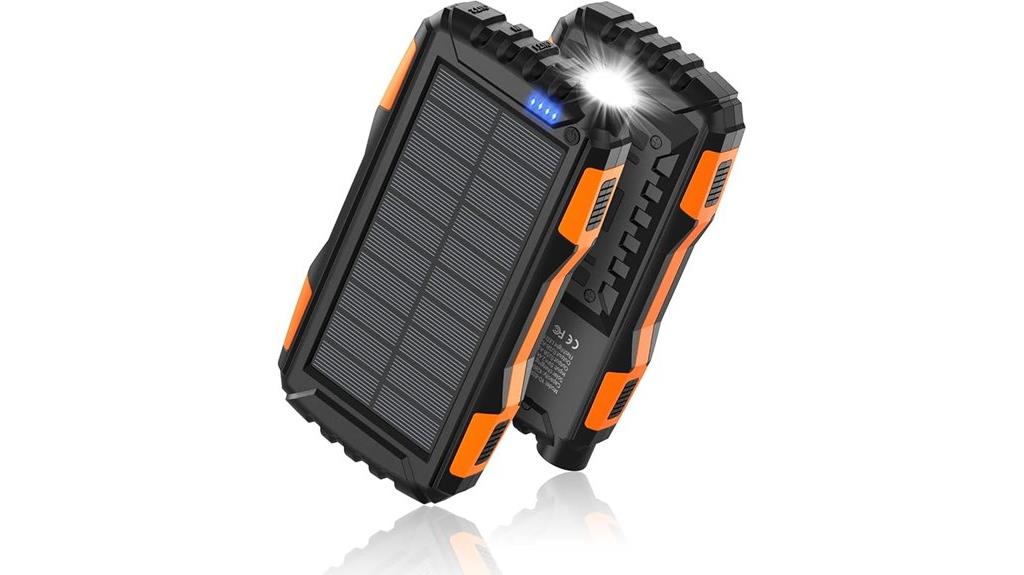
The Power Bank Solar Charger 42800mAh with Flashlight stands out as an ideal choice for outdoor enthusiasts and emergency preparedness, thanks to its rugged design and high-capacity battery. Made from durable ABS material, it’s resistant to chemicals, heat, water, dust, and drops, making it suitable for extreme conditions. Its 42800mAh capacity can charge all USB devices, including smartphones and tablets, with fast QC3.0 charging support. The built-in super bright LED flashlight lasts up to 100 hours, perfect for emergencies. While solar charging is slow and best used in emergencies, the power bank’s toughness and large capacity make it a reliable off-grid companion.
Best For: outdoor adventurers, emergency preppers, and anyone needing a durable, high-capacity power source in extreme conditions.
Pros:
- Rugged design with IP67 waterproof, dust-proof, and drop-proof features for outdoor durability
- High-capacity 42800mAh battery supports fast QC3.0 charging for multiple devices
- Built-in super bright LED flashlight with up to 100 hours of continuous illumination
Cons:
- Solar charging is slow and primarily suitable for emergency use only
- Large size and weight may reduce portability for everyday carry
- Charging via solar panel depends heavily on sunlight conditions, which can vary
Portable Power Station with Foldable Solar Panel (146Wh)
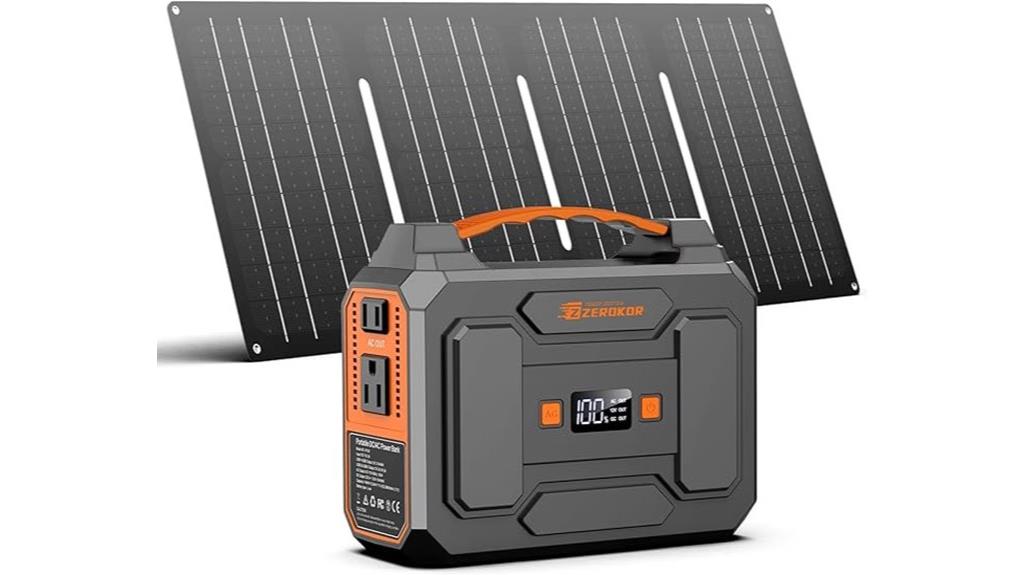
Outdoor enthusiasts and emergency preppers will appreciate the portability and versatility of the ZeroKor 146Wh solar power station. This compact kit includes a 100W lithium-ion battery and a 40W foldable monocrystalline solar panel, ideal for camping, RV trips, or emergency backup. It offers reliable AC and DC power, charging devices like smartphones, laptops, and cameras under 100W. The built-in BMS protects against short circuits, over-voltage, and overheating, ensuring safety. Recharged via wall outlet, solar panel, or car, it’s a low-noise, eco-friendly solution for off-grid power needs. Its lightweight design makes it easy to carry, making it perfect for outdoor adventures or unexpected outages.
Best For: outdoor enthusiasts, campers, and emergency preppers seeking a portable and eco-friendly power solution for devices under 100W.
Pros:
- Compact and lightweight design ideal for outdoor activities and emergencies
- Multiple charging options including wall, solar, and car power sources
- Built-in BMS provides comprehensive protection for safe operation
Cons:
- Limited to devices under 100W, unsuitable for high-power appliances or air compressors
- Junction box on solar panel is not waterproof, requiring careful handling outdoors
- Solar panel output may be slower in low-light conditions, affecting charging efficiency
BROWEY Portable Power Station with 1024Wh LiFePO4 Battery
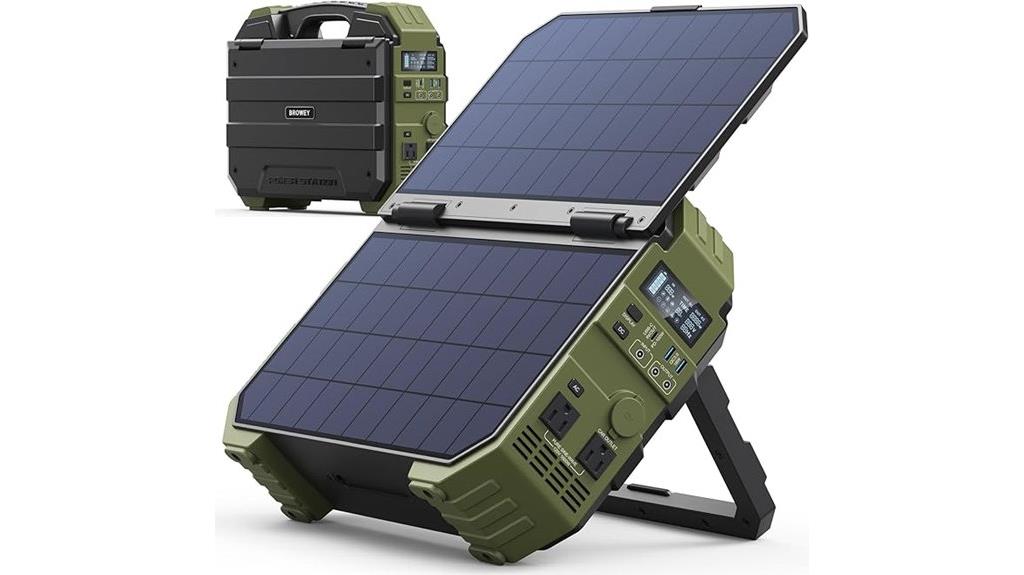
For anyone seeking a reliable, high-capacity power source that can handle refrigerator loads and outdoor adventures alike, the BROWEY Portable Power Station with 1024Wh LiFePO4 battery stands out. It features a sleek design, awarded the iF Design Award 2022, and offers 1600W continuous power with a peak of 3200W, enough to run refrigerators, tools, and appliances. With multiple ports—including USB-C PD 100W—and advanced safety protections, it guarantees safe operation. Its built-in solar panel with MPPT controller allows for efficient solar charging, and it can be recharged via AC, car, or solar, making it ideal for off-grid and emergency use.
Best For: outdoor enthusiasts, emergency preparedness, and off-grid living who need a reliable high-capacity power source capable of running heavy appliances and electronics safely.
Pros:
- High-capacity 1024Wh LiFePO4 battery with over 10 years lifespan and 3000+ cycles
- Powerful 1600W continuous output with 3200W peak, suitable for appliances, tools, and medical devices
- Multiple charging options including solar with MPPT controller, AC, and car outlet for versatile recharging
Cons:
- Slightly heavier and larger compared to smaller portable power stations, which may affect portability
- Higher upfront cost due to advanced battery and design features
- Limited to 80% charge in 3 hours via AC and USB-C PD simultaneously, which may be slow for rapid recharging needs
EF ECOFLOW Portable Power Station DELTA 3 (1024Wh)

If you need a reliable power source that can handle heavy loads and keep your refrigerator running during outages or off-grid adventures, the EF ECOFLOW Portable Power Station DELTA 3 (1024Wh) stands out. It offers 1800W continuous power with a surge capacity of 3600W, thanks to X-Boost technology that supports heavier devices up to 2600W. It charges quickly—80% in just 45 minutes—and can fully recharge with a 500W solar panel in around 2.5 hours. Built with durable LiFePO4 batteries rated for over 10 years, it includes a smart UPS for seamless power switching and can be managed easily via the EcoFlow app.
Best For: those seeking a reliable, high-capacity portable power station for home backup, outdoor adventures, or RV use that can handle heavy loads and ensure uninterrupted power.
Pros:
- Supports heavy loads up to 2600W with X-Boost technology, ideal for appliances and electronics
- Fast charging: reaches 80% in just 45 minutes and fully recharges with solar in approximately 2.5 hours
- Durable LiFePO4 batteries rated for over 10 years of daily use, ensuring long-term reliability
Cons:
- Higher initial cost compared to smaller or less feature-rich power stations
- Requires optional solar panel for renewable recharging, which may be an additional expense
- Bulkier design may be less portable for very lightweight or minimalist outdoor setups
Solar Power Bank 20000mAh Wireless Portable Charger with 3 Cables
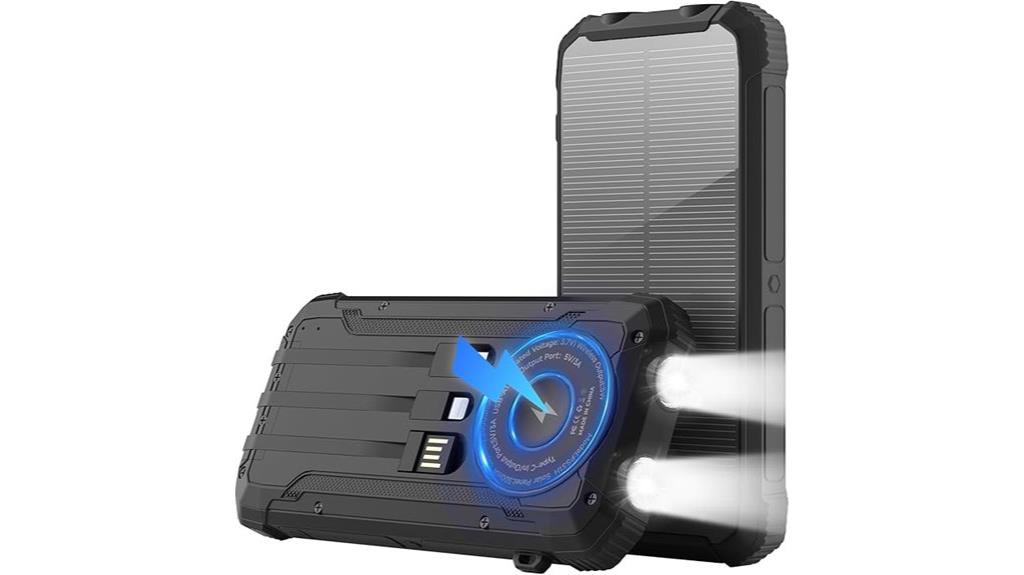
The Solar Power Bank 20000mAh Wireless Portable Charger with 3 Cables stands out as an ideal choice for those who need reliable, versatile charging on the go. Built with a durable, military-grade shell and IP67 waterproof, dustproof, and shockproof resistance, it’s designed for tough outdoor conditions. Its high-capacity battery can charge multiple devices simultaneously, including an iPhone 15 or iPad multiple times, with fast charging capabilities. The built-in 3-in-1 cable supports USB-C, Lightning, and Micro-USB, making it highly compatible. Plus, the solar panel offers emergency power in sunlight, while safety features and an LED flashlight enhance its outdoor utility.
Best For: outdoor enthusiasts, travelers, and anyone needing a durable, multi-device portable charger with emergency solar power.
Pros:
- Rugged construction with military-grade shell and IP67 waterproof, dustproof, shockproof resistance for tough environments
- Large 20000mAh capacity supports multiple devices and fast charging, including iPhone 15 and iPad
- Built-in 3-in-1 cable and LED flashlight provide convenience and emergency lighting in outdoor settings
Cons:
- Solar charging is slower and best used for emergency top-ups rather than primary power source
- Bulky design may be less portable for everyday use when compared to smaller chargers
- Solar panel effectiveness depends on sunlight conditions, which can vary and limit charging speed
BLAVOR Solar Charger Power Bank 10,000mAh with USB C and Flashlight
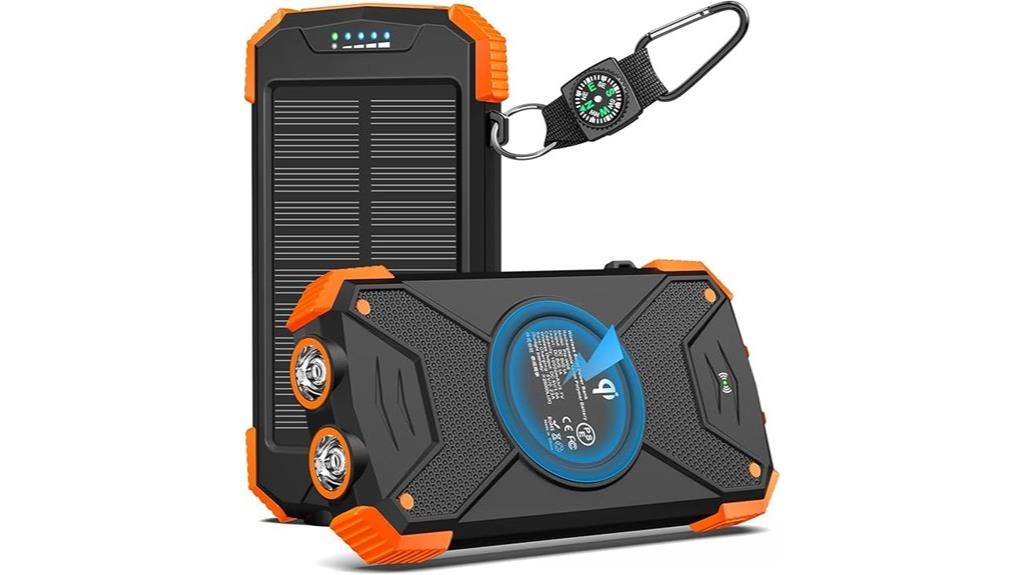
The BLAVOR Solar Charger Power Bank 10,000mAh stands out for outdoor enthusiasts who need a reliable, eco-friendly power source. Its high-quality materials, including flame-retardant ABS and waterproof silicone, guarantee durability in tough conditions. With 20W fast charging via USB-C, it can quickly power up devices like iPhones and tablets without damage. Its compact design makes it easy to carry, while the built-in dual flashlights and compass add safety during outdoor adventures. The solar panel supports eco-friendly recharging, making it perfect for camping or emergency use. Overall, it’s a versatile, durable power bank that combines efficiency with outdoor-ready features.
Best For: outdoor enthusiasts, travelers, and emergency preparedness individuals seeking a durable, eco-friendly power bank with fast charging and safety features.
Pros:
- High-quality, durable materials including flame-retardant ABS and waterproof silicone for tough outdoor conditions
- Fast 20W USB-C charging capable of powering devices quickly without damage
- Built-in dual flashlights, compass, and solar panel for enhanced safety and eco-friendly recharging
Cons:
- 10,000mAh capacity may require multiple charges for larger devices over extended periods
- Solar charging can be slow and dependent on sunlight conditions
- Slightly bulkier compared to ultra-compact power banks, which may be less convenient for minimalists
Enginstar 296Wh Portable Solar Generator
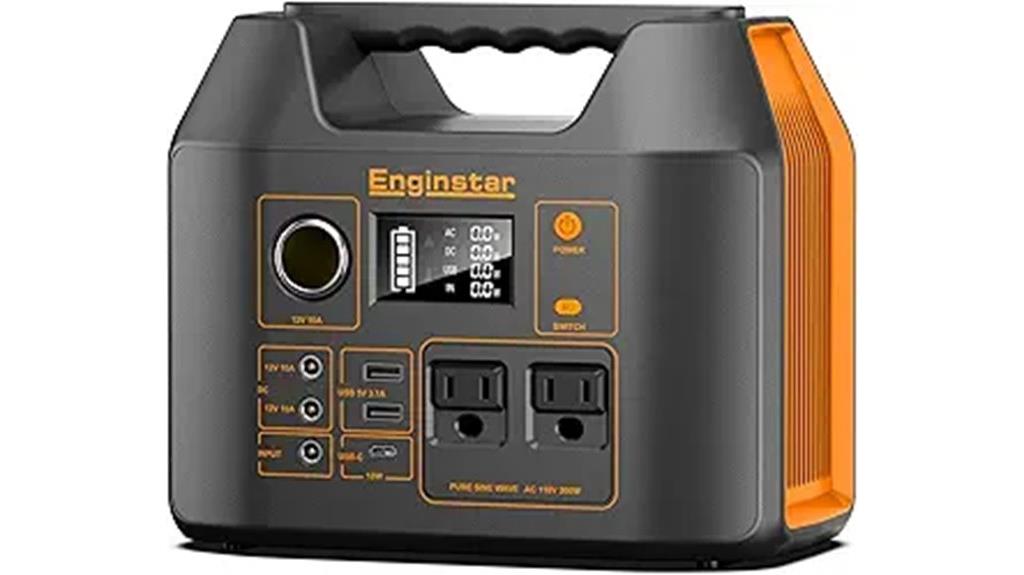
Designed for outdoor enthusiasts and emergency preparedness, the Enginstar 296Wh Portable Solar Generator offers a compact and lightweight power solution that can keep your essential devices running off-grid. Weighing just 6.5 pounds and measuring 9×5.5×7.5 inches, it’s easy to carry anywhere. It features two 110V pure sine wave outlets, USB-C fast charge, and multiple DC ports, making it versatile for phones, laptops, or small appliances under 300Wh. You can recharge it via wall, solar, or car, ensuring reliable power during camping, emergencies, or off-grid adventures. Its built-in LED light and large LCD display add convenience and ease of use.
Best For: outdoor enthusiasts, campers, and emergency preppers seeking a lightweight, portable power source for devices under 300Wh.
Pros:
- Compact and lightweight design (6.5 lbs, 9×5.5×7.5 inches) for easy portability.
- Versatile charging options including wall, solar, and car, suitable for off-grid use.
- Multiple outlets including pure sine wave AC, USB-C fast charge, and DC ports for various devices.
Cons:
- Limited to devices under 300Wh; not suitable for high-capacity appliances like refrigerators or heaters.
- Solar charging requires purchasing a separate solar panel.
- Battery capacity may require frequent recharging during extended use or multiple device charges.
Portable Power Station 300W with Solar Generator and Lithium Battery
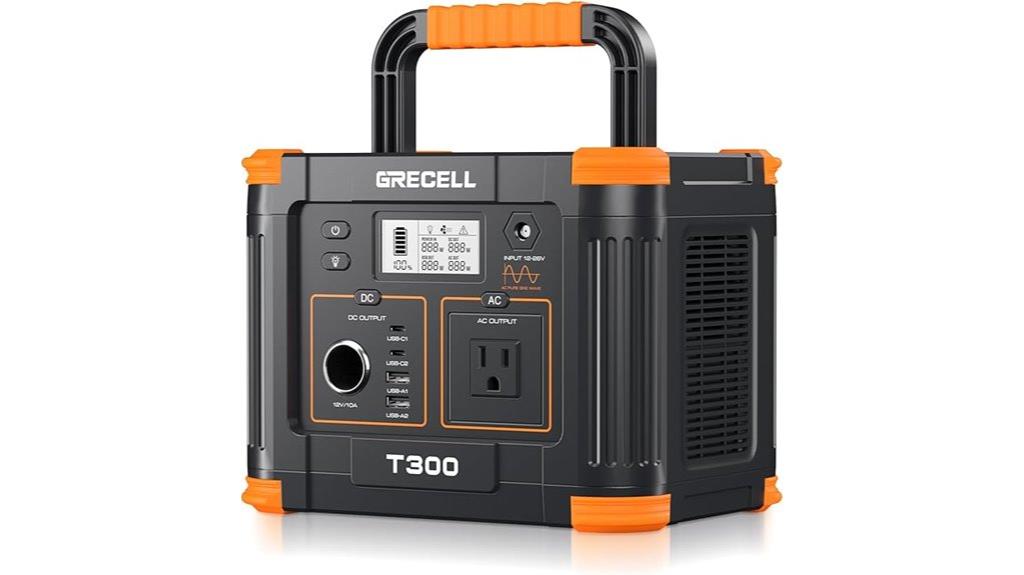
If you’re looking for a compact, reliable power source to keep your essential devices running during outdoor adventures or power outages, the Portable Power Station 300W with Solar Generator and Lithium Battery is an excellent choice. It features a 230.88Wh capacity, supporting laptops, phones, mini-refrigerators, and small appliances rated below 330W. Weighing just 7.3 pounds, it’s lightweight and easy to carry. With six versatile ports, fast-charging USB-C, and multiple recharging options—solar, AC, or car outlet—it’s perfect for outdoor use. Its upgraded lithium battery and built-in MPPT controller ensure efficient, safe power delivery wherever you go.
Best For: outdoor enthusiasts, campers, and homeowners seeking reliable portable power for small devices and appliances during outdoor activities or power outages.
Pros:
- Compact and lightweight design (7.3 pounds) for easy portability
- Supports multiple charging methods including solar, AC, and car outlet for versatile use
- Fast-charging USB-C PD 60W port and multiple outputs for simultaneous device charging
Cons:
- Limited capacity of 230.88Wh may not power larger appliances for extended periods
- Supports devices rated below 330W, restricting use with higher wattage appliances
- Solar panel output (40W) may result in slower recharging compared to larger panels
Jackery HomePower 3000 Portable Power Station with Solar Panels

For anyone seeking a reliable backup power source that can handle high-demand appliances like refrigerators during outages, the Jackery HomePower 3000 Portable Power Station with Solar Panels stands out. It delivers 3600W (surge 7200W), enough to start and run a fridge for up to two days. Its 3072Wh LiFePO4 battery offers long-lasting performance with 4,000 cycles and maintains 70% capacity. Lightweight at 59.5 pounds and compact, it supports multiple charging options, including solar, AC, car, and gas generators. With built-in UPS and advanced ChargeShield 2.0 tech, it guarantees seamless power during outages, making it an excellent choice for home backup and outdoor use.
Best For: homeowners, outdoor enthusiasts, and emergency preparedness individuals seeking a reliable, high-capacity backup power solution capable of running essential appliances during outages and outdoor adventures.
Pros:
- High surge capacity of 7200W ensures smooth starting of high-demand appliances like refrigerators.
- Long-lasting LiFePO4 battery with 4,000 cycles and 70% capacity retention offers durability and extended use.
- Supports multiple charging options including solar panels, AC, car, and gas generators for versatile energy replenishment.
Cons:
- Relatively heavy at 59.5 pounds, which may impact portability despite its compact design.
- Price may be higher compared to smaller or less feature-rich portable power stations.
- Solar panel charging takes up to 9 hours to reach 80%, which may not be ideal for urgent or quick recharges.
Solar Powered Portable Generator 300W with Solar Panels
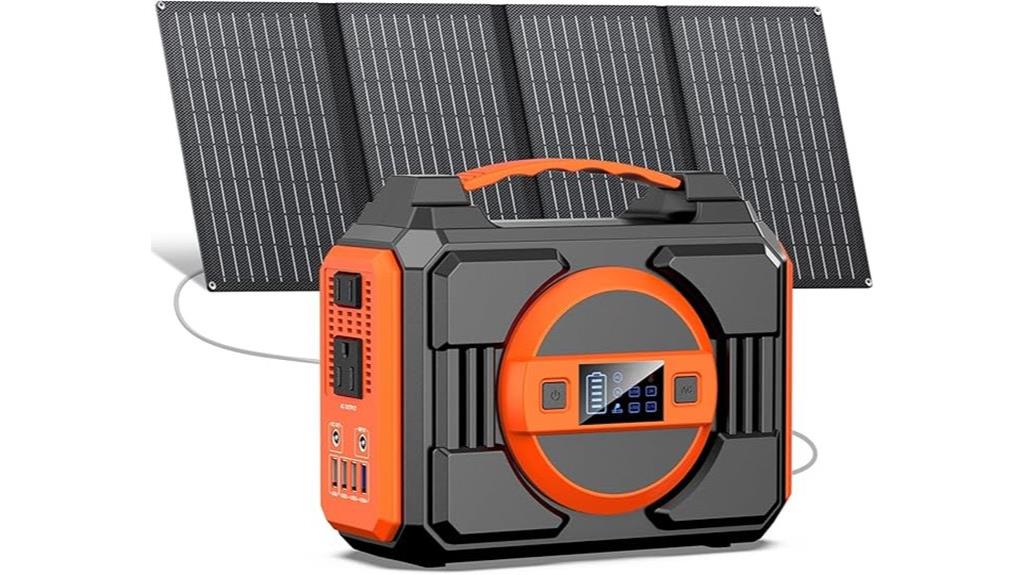
The Solar Powered Portable Generator 300W with Solar Panels is an excellent choice for outdoor enthusiasts and emergency preppers who need reliable, compact power on the go. Its 40W monocrystalline solar panels boast 24% efficiency, performing well even in low-light conditions. The sleek, lightweight design weighs just 5 pounds and measures 8.5 x 6.7 x 4.1 inches, making it easy to carry. With a 220Wh lithium-ion battery, it can charge up to seven devices simultaneously. Multiple outlets, including AC, USB, and DC ports, ensure compatibility. Plus, safety features like a Battery Management System and bright LED light make it versatile and dependable for outdoor or emergency use.
Best For: outdoor enthusiasts, emergency preppers, and travelers seeking a portable, reliable power source for outdoor activities or emergency situations.
Pros:
- Compact and lightweight design weighing only 5 lbs for easy portability.
- High-efficiency 40W monocrystalline solar panels perform well under low-light conditions.
- Multiple charging options with 7 outlets, including AC, USB, and DC ports, supporting up to 7 devices simultaneously.
Cons:
- Limited 300W power output may not support high-power appliances.
- Battery capacity of 220Wh might not be sufficient for extended use without recharging.
- The solar panels’ 40W capacity may result in longer charging times in low sunlight conditions.
Factors to Consider When Choosing a Solar-Powered Battery Bank for Refrigerator

When selecting a solar-powered battery bank for your refrigerator, I recommend considering your power capacity needs to make certain it can handle your daily usage. It’s also important to check if the unit is compatible with your refrigerator and offers flexible charging options. Finally, prioritize durability and safety features to keep your setup reliable and secure over time.
Power Capacity Needs
Understanding your refrigerator’s power capacity is essential to choosing the right solar-powered battery bank. First, determine its wattage to verify the battery can support its runtime. Multiply this wattage by the hours you want it to operate daily to find the total energy requirement. It’s wise to select a battery capacity that offers at least 20-30% extra energy to cover inefficiencies and potential future needs. Pay attention to capacity ratings in watt-hours (Wh) or milliamp-hours (mAh) for accurate comparison with your fridge’s energy demands. Additionally, confirm that the battery bank’s maximum continuous output can handle your refrigerator’s startup surge and running wattage. Properly evaluating these factors guarantees your battery bank can reliably power your fridge off-grid.
Compatibility With Refrigerator
Matching your refrigerator’s power requirements with a compatible solar-powered battery bank guarantees reliable off-grid operation. First, verify the battery bank’s continuous wattage output can handle your fridge’s running wattage, usually between 100W and 250W for small models. It’s also essential to confirm that the surge capacity can manage the initial startup wattage, which can be 2-3 times higher. Check that the voltage matches your refrigerator’s needs, typically 110V or 120V in North America, to prevent electrical issues. Additionally, confirm the battery’s capacity can provide enough runtime based on your fridge’s consumption. Finally, ensure the battery bank’s connectors and outlets are compatible with your refrigerator’s power cord or plug. Proper compatibility ensures a seamless and efficient off-grid refrigeration experience.
Charging Method Options
Choosing the right charging method for your solar-powered battery bank is essential to guarantee reliable and flexible off-grid refrigeration. I look for options like solar panels, AC wall outlets, or vehicle adapters, so I can recharge in varied situations. It’s important to check how long each method takes—solar charging might need 5-6 hours in full sun, while AC charging typically takes around 4-5 hours. Matching the solar input capacity, such as 40W or 21W panels, to my energy needs and sunlight availability ensures efficient recharging. I also verify if the battery bank supports pass-through charging, so my fridge can run while recharging. Safety features like overcharge protection and compatible connectors give me peace of mind during recharging, making the system more reliable and versatile.
Port Selection Flexibility
When selecting a solar-powered battery bank for my refrigerator, I pay close attention to the port options available. I look for models with multiple output ports, like AC, USB, and DC, so I can connect different appliances and accessories easily. Adjustable or modular port configurations are a plus, as they let me customize the setup based on my refrigerator’s power needs. I also verify that there are dedicated high-current DC outlets to handle the startup surge power of my fridge. Supporting multiple devices at once is important, so I choose a bank that allows simultaneous connections. Finally, I confirm the ports include compatible connectors and adapters for my specific refrigerator, ensuring seamless and efficient operation.
Durability and Safety
Durability and safety are crucial factors to contemplate because your battery bank will often be used in challenging outdoor conditions. I look for models with a high-quality Battery Management System (BMS) to prevent overcharging, over-discharging, and short circuits, guaranteeing the battery’s longevity. A durable casing made of shockproof and waterproof materials, like IP67-rated designs, is essential for withstanding rain, dust, and rough handling. I also verify the cycle life—ideally over 1,000 cycles—to ensure reliable, consistent performance over time. Built-in safety features such as temperature control and surge protection help prevent damage during operation. Additionally, certifications like UL or CE give me confidence that the battery meets strict safety and quality standards, making it a dependable choice for off-grid refrigeration.
Portability and Size
Portability and size are essential considerations because a solar-powered battery bank needs to be easy to carry and store during outdoor adventures or emergency situations. A compact design, typically under 10 inches long and weighing less than 10 pounds, is ideal for backpacking or mobile use. Larger capacity units may offer more power but tend to be bulkier, making them less convenient to transport. Foldable solar panels are a great feature, as they reduce overall size when not in use and make storage easier. Additionally, handles or carrying cases can substantially improve mobility, especially in rugged environments. Ultimately, balancing size, weight, and functionality ensures you choose a battery bank that’s both powerful enough for your needs and easy to take along wherever your off-grid adventures lead.
Frequently Asked Questions
How Long Can a Solar-Powered Battery Bank Keep a Refrigerator Running Continuously?
A solar-powered battery bank can typically keep a refrigerator running for about 12 to 48 hours continuously, depending on the battery capacity, refrigerator size, and energy efficiency. I’ve found that larger, high-capacity banks last longer, especially when combined with good solar input during sunny days. To maximize runtime, I recommend choosing a battery with sufficient capacity and ensuring your fridge isn’t overly energy-hungry.
What Is the Optimal Solar Panel Size for Off-Grid Refrigeration?
The ideal solar panel size for off-grid refrigeration depends on your fridge’s power needs and local sunlight. I recommend calculating your fridge’s daily energy consumption, then adding a buffer for efficiency. Typically, a 100 to 200-watt panel suffices for small to medium refrigerators in sunny areas. I suggest consulting a professional to guarantee the size matches your specific setup, maximizing efficiency and reliability.
How Do Weather Conditions Affect Solar Battery Bank Efficiency?
Ever wondered how cloudy skies or chilly winds impact my solar battery bank? Weather conditions definitely influence efficiency—I’ve noticed cloudy days reduce power generation, and cold temperatures can sometimes help battery performance, but excessive cold isn’t ideal. I make sure to monitor weather forecasts and optimize placement, so my system stays reliable. Do you think adjusting for weather could help your off-grid setup stay powered through any season?
Can These Battery Banks Power Other Appliances Simultaneously?
Yes, these battery banks can power multiple appliances at once, but it depends on their capacity and the total power draw. I always check the wattage of each device and compare it to the battery bank’s output limits. If I overload it, appliances might shut off or not work efficiently. So, it’s essential to plan and verify your battery bank can handle all your devices simultaneously.
What Maintenance Is Required for Long-Term Battery Performance?
You’ll want to regularly check your battery for corrosion and make sure connections are tight. Keep it clean and dry, and follow the manufacturer’s recommendations for charging cycles. Occasionally, it’s good to perform a capacity test to catch any decline early. When I do routine maintenance, I notice my battery performs more reliably and lasts longer—saving me worry and money while keeping my food perfectly chilled off-grid.
Conclusion
So, there you have it—15 stellar options to keep your fridge humming off the grid. Because who doesn’t want their leftovers safe and sound without relying on a fancy power grid? Just pick one, plug in, and pretend you’re living in a tiny eco-friendly cabin while binge-watching your favorite show. After all, saving the planet and keeping your food cold—what could possibly go wrong? Happy solar powering!
